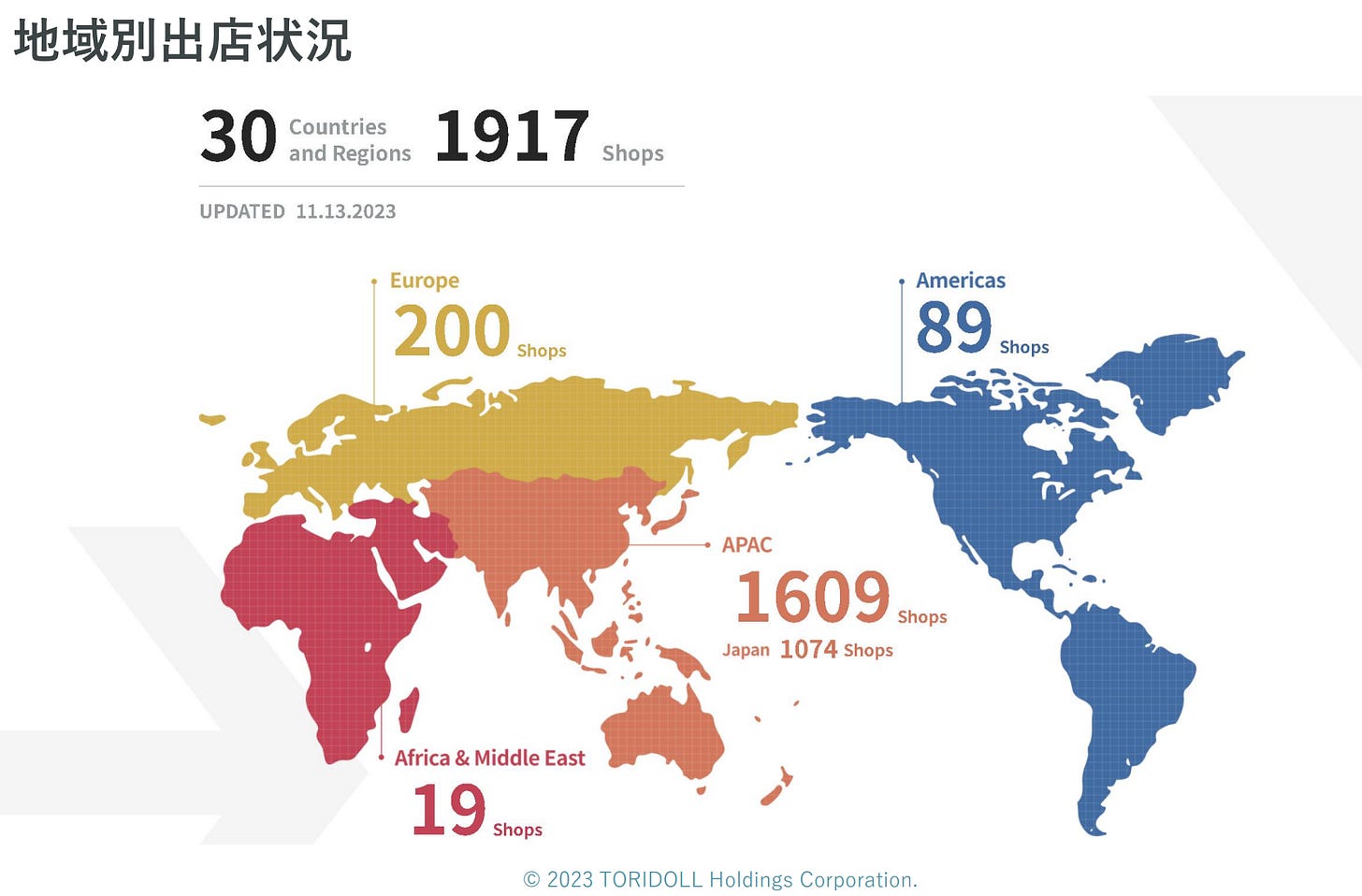Can Toridoll Successfully Expand Marugame's Udon Business in the US?
Japan’s culinary scene is a treasure trove of tradition and innovation. From sushi to wagyu, Japanese cuisine has conquered the world with flavors that touch the soul and a presentation that appeases the eye. However, perhaps none has been as effective in their global conquest as the simple, humble udon noodle. In the vast landscape of culinary exports from Japan, Toridoll's Marugame Udon stands out as a major player, aiming to spread its roots in distant American soil.
About TORIDOLL Holdings Corp
Toridoll is one of the largest restaurant companies in Japan. Established in 1954, it has a rich history ripe with evolutions that reflect changing consumer tastes and an unwavering commitment to quality.
Marugame Udon, its flagship brand, is more than a mere eatery; it's a cultural experience, offering handcrafted udon in a fast-paced, interactive dining style. The selection and ingredients are usually displayed for customers, embodying the 'fast, fresh, and casual' philosophy that has become increasingly popular worldwide.
Today, Toridoll's Marugame Udon boasts a network of over 1,000 restaurants worldwide. Their presence may not be as ubiquitous in the US, but their ambitions are as vast as the Grand Canyon. Their first store in Hawaii, opened in 2011, was a strategic springboard for potential expansion to the mainland.
As of this writing, there are 11 stores in California, 1 in Dallas, and 2 in Hawaii. Globally, TORIDOLL Holdings has 21 brands in total.
TORIDOLL Holdings Corp's December 2023 financials show:
Revenue: ¥59.74 billion or $460M at $1=130JPY (up 22.18%)
Net Income was reported at ¥1.96 billion (up 945.21%). This indicates a significant increase in profitability.
Net Profit Margin: 3.29% (up 765.79%): This implies a significant improvement in profitability relative to revenue.
Operating Income: ¥3.77 billion (up 108.29%)
Their growth and success can be attributed to their strong commitment to quality, innovation, and customer satisfaction. Toridoll constantly strives to improve and adapt its business model to meet changing consumer demands, ensuring it stays competitive in the ever-evolving food industry.
As of November 2023, they had 1,917 stores in Japan and 843 stores globally outside of Japan. So far, they have expanded their business into 30 countries and plan to have 5,500 stores globally by March 2028.
The Birth of Toridoll and the Rise of Marugame Seimen
Toridoll Holdings Corporation, the company behind the popular Marugame Seimen udon noodle chain, has an interesting history that reflects its founder's entrepreneurial spirit and adaptability.
The company's origins can be traced back to 1985 when founder Takaya Awata opened a yakitori restaurant called "Toridoll Sanbankan" in Kakogawa City, Hyogo Prefecture. To own three restaurants in the future, Awata set out to establish a different style of yakitori restaurant than the traditional red-lantern establishments.
In response to the growing popularity of Western-style dining among young women, Awata created a unique yakitori restaurant targeting this demographic. The concept was initially a hit, but the restaurant soon faced competition from Italian restaurants and creative cuisine establishments that drew away its clientele. The restaurant's focus on young women also meant that other customer segments, such as local salarymen, families, and older patrons, were not adequately catered to, leading to their decline in visits.
Despite the failure of this Western-style yakitori venture, Toridoll's traditional yakitori restaurants remained successful. Their focus on genuine hospitality and catering to local clientele, including salarymen, families, and older patrons, had fostered a loyal customer base.
This experience instilled in Awata the importance of creating establishments that were beloved by the local community. This led to the opening of "Toridoll," a yakitori family dining restaurant. Toridoll quickly gained popularity as an affordable dining option for families, and the chain expanded steadily.
However, the 2004 bird flu outbreak in Asia, including Japan, raised concerns about Toridoll's reliance on yakitori. Awata, whose father hailed from Kagawa Prefecture and had introduced him to Sanuki udon from a young age, decided to shift the company's focus to Marugame Seimen, a Sanuki udon restaurant chain he had established in 2001 to offer affordable udon to the people of Kakogawa.
This decision proved to be a turning point for Toridoll. Marugame Seimen's popularity surged, and the chain became the cornerstone of Toridoll's success. The company's adaptability and willingness to embrace new opportunities have been instrumental in its growth and evolution.
What Makes Marugame Udon Unique
In a market teeming with multinational noodle chains, what makes Marugame Udon unique? The answer lies in its traditional cuisine approach and contemporary business practices. At its core, Marugame Udon thrives on the authenticity of its dishes; their handcrafted udon is made fresh daily, a rare sight in a fast-food restaurant. The commitment to traditional techniques while ensuring speedy service sets them apart.
Marugame Udon also leverages its integrated dining experience.
Customers can watch the udon noodles being made, enjoy a selection of freshly fried tempura, and customize their dishes with various toppings, sauces, and condiments. This transparency in process and emphasis on personalization create a unique bond between the diner and the food.
The Story Behind Marugame's Success
Toridoll’s story is not merely one of a food chain's logistical conquest but a narrative rich in innovation and adaptability. The company’s success lies in balancing consistent quality with evolving consumer expectations. They’ve managed to do what many others find hard—marrying tradition with modernity. This harmonious blend has propelled them from a local favorite to an international success.
The first US Marugame Udon store began its global strategy in Hawaii. With a meticulous approach to cultural adaptation and menu localization, the brand has resonated with American food lovers, especially those who appreciate Japanese flavors. Each step into a new market has been cautious, respectful of local culture, and attuned to customer feedback.
Embracing Technology
The Toridoll experience shows that making it big in the US market isn't just about copying a successful idea from another country. It's all about getting to know the local scene well, analyzing the market carefully, and being ready to tweak things without losing what makes your brand special. The big takeaway? Be smart about catching onto global trends and what locals like, and craft a brand story that hits home personally.
If you aim to make a splash in the American dining scene, getting the lowdown on what consumers want and the latest trends is key. It's not only about the grub; it's the whole vibe—from the moment customers step into the moment they leave with big grins on their faces.
The Marugame Udon in Torrance has a menu on a digital board that other Marugame stores in Japan don't have. The idea was to simplify ordering and paying for customers while maintaining a modern and high-tech vibe. It shows that even traditional brands can embrace technology without losing their essence.
The Torrance location also offers a self-checkout system, which allows customers to order and pay for their meals without interacting with staff. This streamlines the ordering process and caters to those who prefer minimal human interaction.
Can Toridoll Successfully Expand Marugame's Udon Business in the US?
While Toridoll's success in the US market with its Marugame Udon brand is impressive, it raises the question of whether other Japanese brands can replicate this success. The key to Toridoll's growth in the US has been its willingness to adapt and embrace technology to cater to local preferences.
The majority of the customers who line up to eat their udon are Asians. Their success can be attributed to their strong understanding of Japanese and American culture. By infusing traditional elements with modern technology, they created a unique dining experience that resonates with both cultures.

So, how can other Japanese brands follow suit? One way is to conduct thorough market research on local preferences and trends. This could include incorporating digital menus, offering self-checkouts, and even incorporating fusion dishes catering to local tastes.
Their location selection likely emphasizes the importance of understanding the local markets with enough demographic base to support their business. This allows them to better cater to their target audience's specific needs and preferences.
Waikiki, Torrance, Cupertino, San Ramon, Sawtelle Los Angeles, Arcadia are all locations where they have opened their Marugame Udon restaurants. These areas are known to have a large Asian population, making it easier for them to attract customers who are already familiar with udon and Japanese cuisine.
However, this does not mean that other locations without a significant Asian demographic cannot succeed. By understanding the local market and adapting accordingly, Japanese brands can also thrive in areas with diverse cultures.
Building a strong brand identity is crucial in standing out in a competitive market like the US. Toridoll's Marugame Udon has become synonymous with authentic Japanese udon, and this reputation has helped them gain a loyal following.
Subscribe to Learn About Japanese Businesses
The expansion of Marugame Udon into the US is just one story among countless others that have graced the business world. It's a tale of ambition, grit, and the pursuit of flavor. For those eager to script their culinary adventures, learning from this fusion of Eastern roots and Western aspirations is important. Delve into the psyche of the American consumer; understanding them is the key to unlocking the potential of the American market.
For further insights into navigating the complexities of international business, I invite you to subscribe to our newsletter. With our data-driven strategies and case studies, you can prepare to serve not just the stomachs but also the minds and hearts of the American populace. After all, as any great chef will tell you, a dish that can captivate all senses is worth serving.





